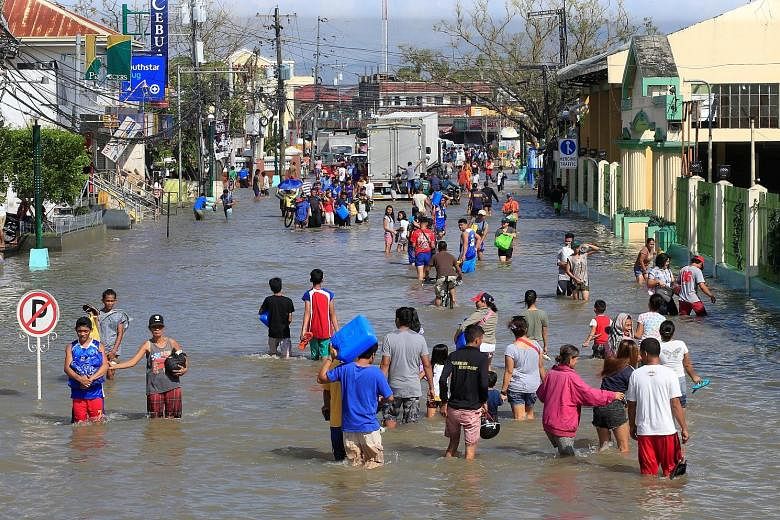Two days ago, new mother Suhaili Saharuddin had to wade through waist-deep water with her two- week-old baby to get to a relief centre in Kemaman, in Malaysia's Terengganu state. It was 3am.
"I was sleeping when my husband woke me up, saying water had entered the house," she told The Star news site. "I panicked because of my newborn baby, but we decided to evacuate," she said.
Ms Suhaili, 21, was just one of the many thousands in the region who faced upheaval as heavy rain lashed the region over Christmas, wreaking havoc on homes, highways and even the power supply.
The worst-hit was the Philippines, where Typhoon Nock-Ten claimed six lives, with another 18 people missing. The Christmas Day storm missed the capital city of Manila, home to some 13 million people, but sank a ferry and brought down the power supply in the country's eastern provinces. Farms, schools and hospitals were damaged in the strong winds, and more than 400,000 people had to be evacuated from their homes.
Meanwhile, Australia's semi-arid desert in the Northern Territories received record rainfall on Christmas Day, creating waterfalls that streamed down Ayers Rock, a sandstone formation also known by its aboriginal name, Uluru.
Two tourists were washed away in the torrent as their car was swept off the highway but they were later found safe, reported the Australian Broadcasting Corporation. A family of six is believed to be missing, prompting a helicopter search.
In Indonesia, more than 104,000 people were forced to leave their homes on Christmas Eve after severe flooding hit Bima, a low-lying city in West Nusa Tenggara province, about 500km east of Bali Island. Floodwaters were up to 3m deep, and a state of emergency has been declared until Jan 4.
Even Singapore was not spared, with flash floods hitting on Christmas Eve, forcing shoppers in Orchard Road to wade through ankle- deep water.
Water levels at eateries in Upper Thomson were even higher, rising to knee-high levels after the downpour and partially submerging parked cars.
Meanwhile, Singapore can continue to expect passing showers over the next few days, with heavier rain at the weekend.
For the residents of north-east Malaysia, the end is also not in sight. The meteorological department has forecast that heavy rain will continue until the end of the year, and warned residents to brace themselves for more flooding.
Ms Zakiah Zakaria, 36, from Kijal in Terengganu, said that despite the floods happening regularly because of the annual north-east monsoon, she still dreads them. "It comes very fast. We were lucky it happened in the morning and not while we were asleep," she told The Star.
Unusually heavy rain could become more common. Climate scientists have warned that rising global temperatures are likely to mean more severe floods in the future.
Typhoon Nock-Ten leaves six dead, 18 missing
At least six people have died and 18 others have gone missing after Typhoon Nock-Ten lashed the Philippines over the Christmas holidays, the government said as it tried to assess the damage.
The unusually late storm first hit the eastern provinces on Christmas Day, flooding roads and farms, destroying homes and damaging ships as it crossed the archipelago, though the highly populated Philippine capital was spared.
In the worst incident, a ferry known as the MV Starlight Atlantic sank off the coastal province of Batangas, killing one and leaving 18 crewmen missing, the coast guard reported after confirming the number of people on board.
Freak rain turns Uluru into waterfall
Unusual torrential rain in Australia's outback has turned the Uluru monolith into a series of cascading waterfalls and triggered flash floods.
Police were using helicopters yesterday to search for a family of six, missing since the Christmas Day downpour which drenched the desert that is usually sweltering in the midst of the southern summer at this time of year.
A car thought to be carrying three people, believed to be Japanese tourists, was washed off a road into a flooded creek near the town of Alice Springs, police said. Two people managed to get out but police had "grave concerns" for the third person who was trapped as the vehicle was washed away, said Acting Superintendent Brendan Muldoon.
Heavy rain to continue until year end
Downpours and intermittent showers are expected to persist in Malaysia until the end of the year, causing floods especially in the east coast states.
It is north-east monsoon season in the country, which usually lasts from November to March, and the Meteorological Department has issued a heavy rain warning for the states of Pahang, Terengganu and Kelantan.
The capital Kuala Lumpur, Selangor and Putrajaya are also set to experience isolated rain until the new year, mostly in the afternoon and evening.

